Thursday, 19 July 2007
Distance 28 km
Duration 5 hours 20 minutes
Ascent 67 m, descent 78 m
Map 47 of the TOP 100 blue series (now superseded)
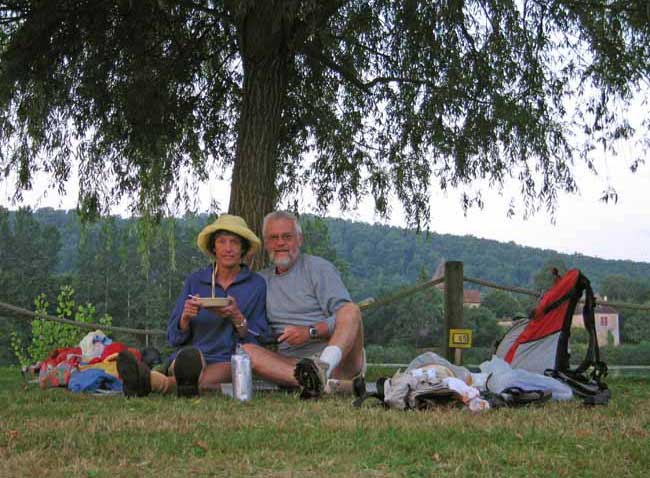
Overnight it had rained but the morning was clear. With a layer of muesli in our stomachs, we left at 6:50, having never found the office, much less paid.
We took the canal path back to Lalinde, where we crossed to the other side of the canal and continued a few more kilometres until we reached the highway from Beaumont.
Here we left the canal path and headed towards the bridge over the Dordogne.
We were wondering whether it was worth going into the village of Couze, which was slightly out of our way, in search of coffee, when we came to a boulangerie and bar, just before the bridge, with a view of the river Couze spilling out over a causeway into the Dordogne.
Inside was the usual group of local drinkers, kept under control by a pair of determined middle-aged matrons. We had pastries from next door with our coffees, which were weak but large.
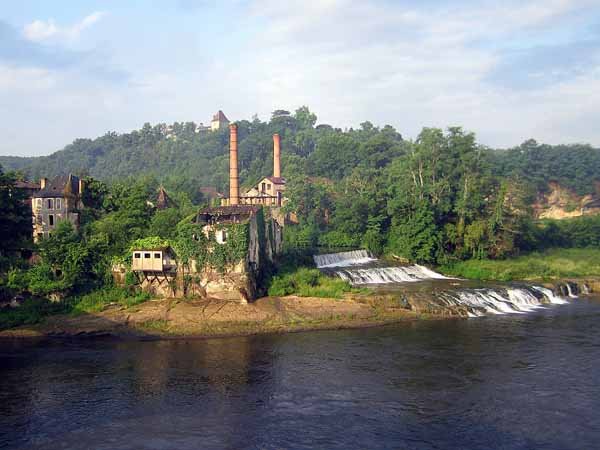
As we sat there, a sudden rainstorm blew up out of a clear sky, and the women hurried outside with the pot plants from the bar, presumably to wash the smoke and ash off them.
We waited until the squall had passed, chatting with our hostesses, who told us that the shopkeepers and tourist operators in the area were in despair this year, with all the bad weather. The tourists were staying away.
After crossing the bridge we took the first road to the right, the D37, a road that went nowhere except to the local hamlets. We passed Varennes and Saint-Agne, and pressed on through water meadows planted predominantly with vines and maize. A couple of hours took us to the intersection where a bridge went over to Mouleydier on the highway, and, reasoning that anything on the highway was likely to have a bar, we crossed the river.
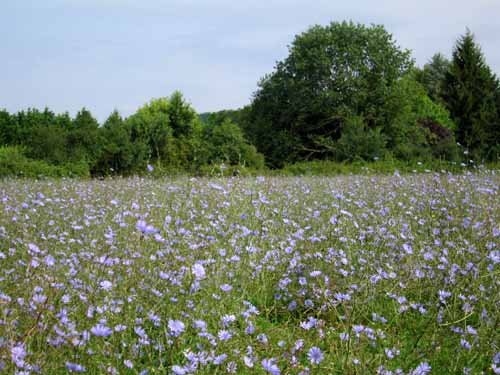
We were immediately vindicated, and had coffee under a red umbrella at a corner café, while an unbroken line of cars, trucks and caravans crawled past.
Back over the bridge, on our deserted thread of road, we soon approached he straggling village of Cours-de-Pile, taking the low road around it and finding ourselves among the roadworks for the new Bergerac bypass.
We went along beside it for a time, then with some difficulty crossed underneath, only to find our road doubling back annoyingly, only a few metres away from where we had just come in the opposite direction. Finally we crossed to the right bank of the Dordogne and joined the main road as it entered the streets of the town.
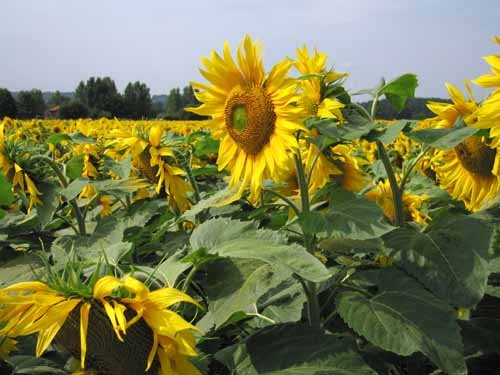
However, this did not mean that we were near the centre. We had first to trudge past an enormous ruined factory site, now partially reclaimed as a small tradesmen’s collective, but the good thing was that its tall stucco outer wall cast a line of shade on the footpath and gave us some relief from the hot midday sun.
At the first roundabout there was a Camping sign pointing over the bridge, and for lack of a better idea, we followed it, although we knew from experience that we could be going on a long circuitous route, possibly kilometres out into the country. To our great relief we ended up back on the river, not a stone’s throw from the old bridge and directly opposite the centre of town.
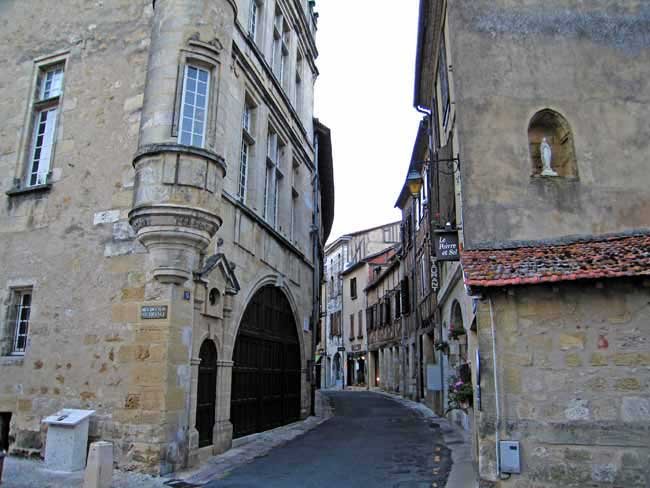
It was a municipal camping ground with huge spreading trees and hardly any grass underneath. We pitched our tent on dust, and Keith strung the clothesline from a tree to a post, only to be politely informed that it was across the boules court, so it had to go.
In the office there were photos of the place under a swirling sheet of floodwater and also deep in snow, with campervans half-buried.
The showers were impressively new and adjustable, and when we were clean we lay in the shade on our mats.
I repaired my walking shoes again with the wonderful glue from Albi, in the hope that they would last another week or two.
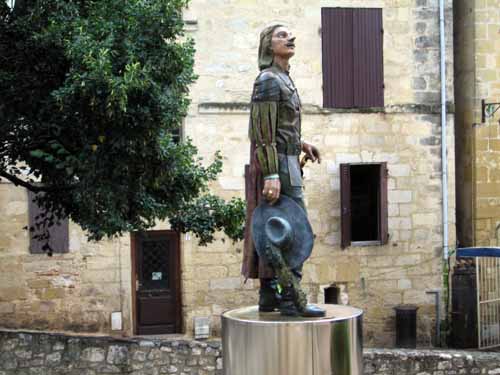
When evening came we stepped over the bridge, passed the old town on our left and went up to the big, modern Place de la Résistance to visit the Office of Tourism.
We discovered that there was camping at Gardonne for tomorrow, but the only camping at Sainte-Foy, our destination in two days’ time, was six kilometres further down the river, near Saint-Antoine-de-Breuilh.
Then we wandered down into the lovely maze of the old town, where cars were banned and many of the streets were staircases. The church of Saint-Jacques was centuries older than the cathedral higher up, and presided over the original village on the river.
In a little square stood a statue of Cyrano de Bergerac, the hero of a nineteenth-century romantic tragedy, in which Cyrano, talented but ugly, selflessly helps his friend to obtain the affections of the woman that they both love.
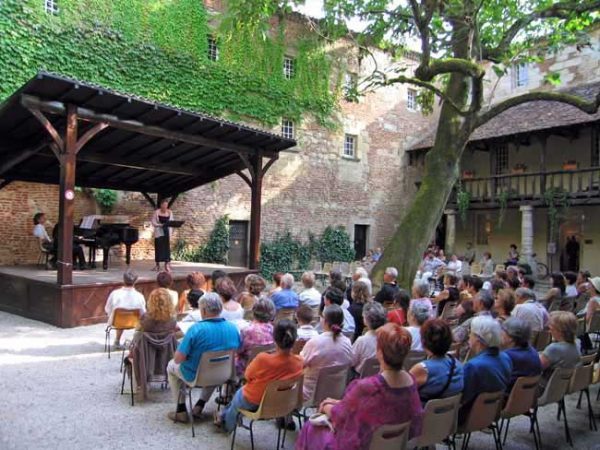
There was a real Cyrano de Bergerac, but the one in the play is not him, and indeed has no connection with Begerac. This has not stopped the town from cashing in on his name.
While we were sipping our cold rosé at an outdoor table, we heard beautiful singing coming from a massive wooden door that stood open nearby. Out of curiosity we went in and found ourselves in a cloister, with ivy-clad walls, wooden balconies and a great leaning tree.
There was a concert in progress; a celestial soprano and a pianist were performing to a seated audience. It was the cloister of the seventeenth-century convent of Les Récollets.
For dinner we found a small square, hemmed in by picturesque half-timbered houses and packed with the tables of two separate restaurants. We were lucky to get a table straight away, as later arrivals had to wait on a stone bench against the wall.

At a table near us, four people – three generations of women plus grandpa – were having a celebratory dinner.
They started with two bottles of Champagne, then each had a Carcasse Royale (€25 a plate), a sorry-looking ribcage of a duck, stripped of meat and surrounded by slices of foie gras and cèpes.
It was evidently a delicacy but they did not seem to be getting much nourishment for all their poking and fishing about.
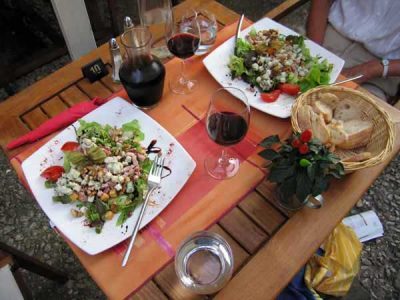
We ordered more humbly, the €14 formula, beginning with two substantial salades du berger, piled high with bacon and pieces of Roquefort.
To follow we had prime steak with green peppercorn sauce, and then a pastry from the dessert trolley. I chose an apricot tart, but I put it away for tomorrow.
This was the third night in a row that it had been warm enough to eat outside, a record for this year, but during the night there were tremendous thunderstorms and heavy rain.
Previous section: Montcuq to Lalinde